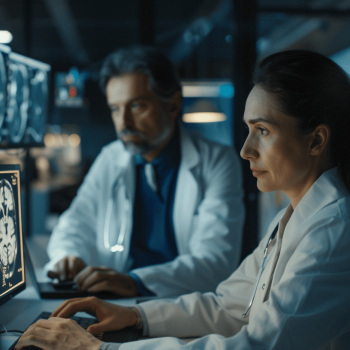April 2, 2024
The landscape of stroke care has dramatically evolved, shaping a new era where cutting-edge advancements and comprehensive insights into stroke pathophysiology redefine patient outcomes. At the heart of this evolution, pivotal studies like MR CLEAN have catalyzed a paradigm shift, underscoring the indispensable role of timely and precise interventions. These breakthroughs have paved the way for the integration of artificial intelligence (AI) into the realm of stroke diagnosis and treatment, offering a beacon of hope and innovation. As we reflect on the journey from the groundbreaking findings of key trials to the present, it becomes evident that AI has become an integral tool in the fight against stroke, transforming the landscape of care with its precision and efficiency.
Artificial Intelligence (AI) technologies have since played a crucial role in advancing stroke diagnosis and treatment, offering innovative solutions to some of the most pressing challenges in the field. AI’s impact on stroke care can be seen in several key areas:
Enhanced Imaging Analysis
AI algorithms have revolutionized the interpretation of neuroimaging for stroke patients. Advanced software can now analyze CT and MRI scans to identify signs of ischemic or hemorrhagic stroke with remarkable speed and accuracy (Lee et al., 2017). This capability is crucial for determining the appropriate treatment path, especially for interventions like thrombolysis and EVT, which are highly time-sensitive.
Triage and Workflow Optimization
AI-powered solutions enable swifter communication and collaboration among stroke care teams, facilitating rapid and informed decision-making. These tools are designed to expedite the evaluation and treatment process for all. By automating and refining the assessment stages, AI significantly minimizes the interval between a patient’s arrival and the commencement of treatment, which is crucial for enhancing patient recovery rates. Additionally, AI technology enhances the workflow efficiency within stroke care teams, promoting seamless coordination and exchange of information among healthcare professionals. (Vuong et al., 2017).
Predictive Analytics
AI models are increasingly capable of predicting outcomes for stroke patients based on a wide array of data, including imaging results, clinical history, and demographic information. These predictions can inform treatment decisions, helping healthcare providers to personalize care plans and set realistic expectations for recovery.
Post-Stroke Monitoring and Rehabilitation
Beyond acute care, AI applications extend to monitoring patients’ recovery and guiding rehabilitation efforts. Wearable devices equipped with AI algorithms can track patients’ progress in real-time, providing actionable insights to adjust rehabilitation strategies for optimal recovery.
Incorporating AI into Stroke Care: Challenges and Opportunities
Despite the promising advancements, integrating AI into clinical practice presents challenges. Issues such as data privacy, interoperability with existing healthcare systems, and the need for robust clinical validation must be addressed. Furthermore, ensuring equitable access to AI technologies across different healthcare settings remains a significant concern.
However, the opportunities afforded by AI in stroke care far outweigh these challenges. By continuously refining AI algorithms and expanding their applications, the healthcare community can enhance the precision, efficiency, and personalization of stroke care.
Looking Forward: Nicolab’s Contribution to the AI Revolution in Stroke Care
As we reflect on the journey from the transformative findings of the MR CLEAN trial to the present, it’s clear that AI has become an indispensable tool in the fight against stroke. Nicolab stands at the forefront of this revolution with StrokeViewer, an AI-driven, cloud-based platform designed to empower healthcare professionals in diagnosing and treating strokes. StrokeViewer exemplifies the cutting-edge innovation in stroke care, offering advanced image analysis, seamless workflow integration, and real-time collaboration tools. By leveraging the power of AI, Nicolab is committed to ensuring that stroke patients receive timely and effective care, irrespective of their location.
As the landscape of stroke care continues to evolve, the potential of AI to save lives and improve outcomes for stroke patients has never been more apparent. We invite healthcare professionals and institutions to explore the possibilities of AI in stroke care further and to consider how solutions like Nicolab’s StrokeViewer can be integrated into their practices to enhance patient care.
Curious about how the journey from the pivotal MR CLEAN trial to today’s cutting-edge advancements in stroke care has reshaped our approach to stroke diagnostics? Explore our insightful article, “The Evolution and Significance of Automatic Motion Correction in Stroke Diagnostics” and uncover how this game-changing technology is enhancing the accuracy and efficiency of stroke diagnosis, setting new standards for patient care.
For those eager to delve deeper into the innovations driving forward acute stroke care and to see firsthand how Nicolab’s StrokeViewer is revolutionizing the field, we invite you to schedule a demo.
Discover the transformative potential of StrokeViewer and learn how Nicolab is contributing to the future of stroke care technology.
Let StrokeViewer improve your team’s stroke workflow
